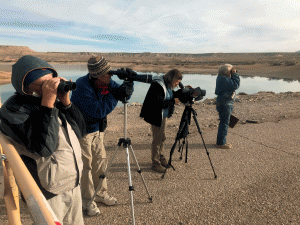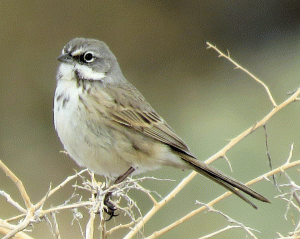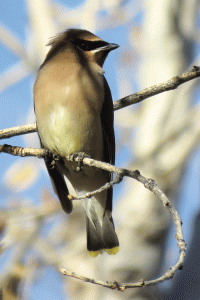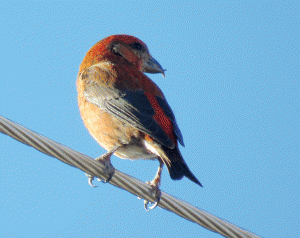By MAGGIE MCMURRAY
Moapa Valley Progress

This year’s annual Muddy River Christmas Bird Count (CBC) was a big success. Volunteers from all over the region met on Sunday, December 31, at Warm Springs. The groups were able to count a total of 7,439 birds from about 92 different species, an increase of over 2,000 birds from last year.
The bird count takes place in the same area every year, which is about a 15-mile diameter circle stretching from Warm Springs to Bowman Reservoir.
The annual count, which is held all over the nation was first begun by the Audubon Society 118 years ago. It is one of the longest-running citizen science events in the world.
The local count has been organized and led by SNWA Environmental Biologist David Syzdek for the past seven years.
“We always have it around this time of year,” Syzdek said. “It’s important to count the birds in the winter so that we can see how habitat changes, land use changes, agriculture, population shift and climate change are affecting our bird populations. We can see long-range trends and see how birds are affected by, and are responding to, all the changes in the world around them.”

This year the count began bright and early at 7:00 am. Most of the volunteers that help at our local count come from Las Vegas, but there are many who come from further away. This year there was a great turnout for volunteers.
“We had 23 volunteers this year, which was great for us,” Syzdek said. “There were so many that we were a bit late getting started while we organized everything. But it was a great problem to have. Every set of eyes really helps and we even love to get help from those people that are less experienced.”
Syzdek said that this year they even had a family from the east coast that drove all the way out here just to help in this bird count and others in the area.
“Bird enthusiasts often keep a life list of birds they have seen,” Syzdek said. “In order to add to that list they have to travel where there are different bird species. This year we had a family from New Jersey who came to help with the Southern Nevada bird counts and they had a fantastic time. The birds we saw were all different from the birds they have in New Jersey.”

Helping with the bird count is a lot of fun for those involved, although it makes for a long day. Volunteers start early in the morning and don’t quit until dusk, around 4:30 pm. They meet up for dinner and work together to compile their various lists.
In many CBC locations, there is also an evening count for nocturnal birds. But the Muddy River count does not participate in this due to limited volunteers. Syzdek said, however, that the spotters stay out after dusk every year until they make sure they count a few owls, which are the primary nocturnal bird in this area.
Participating in the count is a lot of work, but also a learning experience and a labor of love.
“We walk for a good 7-8 miles each and it builds a great camaraderie,” Syzdek said. “Even the experienced birders learn a lot from each other.”
“We all have things we’re good at and we share our tricks with each other as we walk and watch,” Syzdek added. “You learn new songs, new identification techniques, and share experiences as you go along.
Everyone comes out having learned a little more so it’s a win-win situation for everyone involved.”
Syzdek says that one of the most exciting things during the bird count is to spot a rare or unusual bird. There were a few of those this year.
Members of the group spotted a Harris’ Sparrow. This bird usually winters in Texas, making it an exciting rarity for this area.
Another unusual sight was an entire flock of Red Crossbills seen at Warm Springs. This was unusual because Red Crossbills have a crossed beak that is used for plucking seeds out of pinecones. In our relatively pine free area, they are rarely seen, being much more of a mountain bird. Syzdek said it was exciting to see them on the handful of pine trees planted in the Warm Springs area.

One disappointing thing this year was the complete lack of vermilion fly-catchers spotted. The birds typically winter elsewhere, but because it is one of the birds that is managed for at Warm Springs, biologists like to count at least a few every year in the CBC. This year there were none, which is somewhat unusual.
By the numbers, this year’s most-spotted bird was the White-crowned sparrow. At 1,544 birds spotted, it is up from its number two spot last year at 781 birds spotted and approaching the 2012 high of 1,666. The White-crowned sparrow is native to southern NV.
Second place went to the red-winged blackbird with 1197 birds spotted up from 142 last year. Third place went to the European starling, which also held the number three spot last year. Starlings are a less welcome sight because they compete with and evict native birds from their nesting sites.
Noticeably absent from this year’s top three was last year’s winner the Eurasian-collared dove, which competes with the native Mourning dove. Last year there were 1,038 Eurasian-collared doves spotted. This year that number dropped to 24. At the same time, Mourning doves rose from 17 last year to 57 this year.
Syzdek said he is grateful for all those who came and helped with another successful event. He is also grateful to the Moapa Band of Paiutes and NV Energy for allowing access to their land to complete the count, which also takes in Hidden Valley, Warm Springs, Meadow Valley Wash, Bowman Reservoir, and the National Wildlife Refuge.
The group welcomes any and all who would like to participate every year, including amateurs, because every set of eyes counts. More information on the annual count can be found at the Audubon Society’s website at www.audubon.org/conservation/science/christmas-bird-count.
The 2018 CBC by the numbers:
Snow Goose-; Canada Goose-44; American Wigeon-8; Green-winged Teal-12; Mallard-12; Ring-necked Duck-20; Common Merganser-1; Ruddy Duck-10; Gambel’s Quail-477; Pied-billed Grebe-2; Great Blue Heron-4; Great Egret-4; Northern Harrier-11; Sharp-shinned Hawk-8; Cooper’s Hawk-8; Accipiter spp.-2; Red-shouldered Hawk-1; Red-tailed Hawk-32; Ferruginous Hawk-10; Rough-legged Hawk-1; Virginia Rail-2; Sora-1; American Coot-38; Killdeer-63; Wilson’s Snipe-3; Western Sandpiper-6; Ring-billed Gull-57; Sandhill Crane-1; Rock Pigeon-55; Eurasian collared-Dove-24; Mourning Dove-57; Greater Roadrunner-9; Barn Owl-1; Great Horned Owl-1; White-throated Swift-32; Anna’s Hummingbird-5; Hummingbird spp.-1; Belted Kingfisher-1; Red-naped Sapsucker-1; Ladder-backed Woodpecker-10; Northern Flicker (red shafted)-45; Northern Flicker (yellow shafted)-1; American Kestrel-9; Prairie Falcon-3; Black Phoebe-5; Say’s Phoebe-35; Gray Flycatcher-1; Loggerhead Shrike-23; Kingbird spp.-1; Common Raven-113; Horned Lark-97; Verdin-20; Ruby-crowned Kinglet-47; Golden-crowned Kinglet-1; Blue-gray Gnatcatcher-1; Black-tailed Gnatcatcher-32; Brown Creeper-1; Red-breasted Nuthatch-1; Rock Wren-7; Marsh’s Wren-17; Bewick’s Wren-8; Western Bluebird-18; American Robin-82; Northern Mockingbird-36; Sage Thrasher-1; Crissal Thrasher-16; European Starling-815; American Pipit-332; Cedar Waxwing-63; Phainopepia-256; Orange-crowned Warbler-4; Yellow-rumped Warbler (Audubon)-155; Yellow-rumped Warbler (Myrtle)-2; Dark-eyed Junco-2; Dark-eyed Junco, Oregon-33; White-crowned Sparrow-1544; Sagebrush Sparrow-15; Bell’s Sparrow-1; Savannah Sparrow-12; Song Sparrow-53; Lincoln’s Sparrow-8; Abert’s Towhee-100; Harris’ Sparrow-1; Red-winged Blackbird-1197; Western Meadowlark-180; Brewer’s Blackbird-651; Great-tailed Grackle-104; Brown-headed Cowbird-20; House Finch-61; Lesser Goldfinch-143; American Goldfinch-13; Cassin’s Finch-1; House Sparrow-17; Red Crossbill-4.










